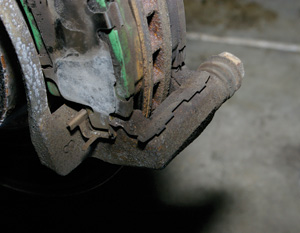 When the driver is pushing on the brake pedal on a Prius, it might not be producing hydraulic braking force. The system is measuring the stroke and pressure generated at the brake pedal and translating that into braking force created by a generator.
When the driver is pushing on the brake pedal on a Prius, it might not be producing hydraulic braking force. The system is measuring the stroke and pressure generated at the brake pedal and translating that into braking force created by a generator.
It is not uncommon to find a Prius with 70,000- or 100,000-miles with the original set of pads. Regenerative braking creating the most of braking f
orce. But, hardware and rubber seals/boots, can’t fail sooner. Corrosion can destroy the abutment clips and get between the friction material and backing plate. This can cause a complete failure of the pads. Always use the best possible pads on a Prius that have a mechanical retention system like the brake pads from NRS Brakes.

Pressure sensors are in the four hydraulic circuits detected any abnormal readings when the hydraulic system was first engaged or in normal operation. The system may have detected low pressure when extra fluid is required to bring the piston into contact with the rotor, or residual pressure from you pushing the piston back. Also, the pressure sensors can detect pulsations caused by Disc Thickness Variation (DTV). If the sensors detect the pressure spikes caused by DTV and lateral runout, it will set a C134X code for Hydraulic system malfunction.
To avoid these problems, make sure the lateral runout is below .001″ and there is no detectable DTV when the pads or rotors are replaced. This can be corrected with an on-the-car brake lathe.
But don’t be scared of the Prius. With the right parts, tools and knowledge is is a job that should not be turned away.
Comments are closed.